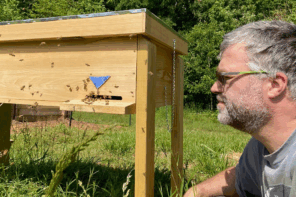Ed Colby
Just when you think you have your bees all figured out, the little darlings will laugh at you and prove you so wrong.
It’s mid-September as I write. Three weeks ago I divided a dozen colonies and put queens from Hawaii in the queen-less halves. They still had on their hula skirts. These were Carniolans mated with Italian drones. Italians aren’t my favorite bees, but most of the queen breeders were shut down for the season, and as Paul once pointed out to me, “Sometimes the best queens are the ones you can get!”
I let the resident bees eat through the candy plugs in the queen cages to release their new monarchs. This is the way to go for beekeepers who don’t have time to open each hive and manually release queens from their cages when they think the colony has accepted them. Manually releasing queens is the sure-fire way, if you know what you’re doing, and you’re looking for a project. I’m not. I have a bunch of bee jobs unfolding more or less simultaneously right now, like pulling and extracting honey, testing and treating for mites, moving colonies down from the Colorado high country, packing honey for sale and tinkering with my sometimes fickle 1983 flatbed Ford. Then there’s the IRS. Despite my reasoned and persistent entreaties, they won’t listen. They gave me a refund, and now they want it back. On top of all this, my gal Marilyn still expects to get taken out on dates. I have to look at the big picture and prioritize.
I’ll overwinter these colonies in single brood boxes stacked two-hives-deep, with only a queen excluder and a sheet of metal window screen separating the two colonies. That way they can share the warmth but not intermingle. Bees from the lower hive go to the top of their super, while those from the upper hive descend to the bottom of theirs, creating a single cluster.
My beekeeping strategy is to charge ahead, always. I either get it right, or I learn from my mistakes. A week ago, I discovered that one of the aforementioned splits had rejected its new queen and created some replacement queen cells. I don’t normally make divisions in late Summer. I make them in the Spring. If an April queen fails to get accepted, the bees won’t tolerate another introduced queen, so I simply let the queen-less split make its own queen. But right now, it’s critical to have a laying queen pumping out eggs that are destined to become Winter bees – those special bees that live all Winter, unlike short-lived Summer bees. This is not the time for a brood break. I didn’t want egg-laying to stop, while a virgin queen hatches, mates and then heads a colony destined to not survive the Winter due to insufficient numbers of Winter bees.
I wanted to put that no-queen split with the queen cells to good use, so I placed it on top of a weaker, queen-right split right next to it, with a sheet of newspaper between the two colonies. Based on what I just told you about queen cells and introduced queens, this made no sense, but I don’t always put two and two together out in the beeyard.
I had an uneasy feeling afterwards, so I called my queen guru Tina. She never minces words. Absolutely I did the wrong thing, she patiently explained. The stronger, no-queen colony would have fidelity not to the laying queen in the other hive, but to its own unhatched queens biding their time in their cells. A murder most foul lay in the offing.
Tina and I had a good laugh over my ineptitude, and we agreed that I’d best get back over to the beeyard first thing in the morning and re-separate those hives. It can take days for colonies to eat through a sheet of newspaper dividing them, so I figured I’d simply undo my mistake, no harm done.
The following morning when I returned to the scene of my blunder, the first thing I saw was a pile of shredded newspaper in front of the hives I’d united the day before. When I lifted off the upper box, I found the newspaper completely eaten away, and the lower, queen-right super – the one containing the weaker colony – completely overrun with bees. Fearing the worst, I took a deep breath and placed the upper super back in its former location. I never even lifted off the cover. Then I drove home.
I’ve been extracting honey this week, but today, I saw enough daylight to check on those two hives again. The no-queen split with the queen cells had run out of brood – and almost out of honey – so I gave it a word of encouragement and fed it some honey-laden wax I’d skimmed off the top of freshly extracted five-gallon buckets.
And the other colony – the queen-right one I feared had been overrun by marauding invaders? It had lots of bees, brood, eggs and honey. Its queen survived the turmoil of being united with what I had assumed was a hostile colony. All was well, after all.
You see? Every assumption I made turned out to be wrong. I lucked out, but the bees got the last laugh.
A Beekeeper’s Life – Tales from the Bottom Board, is an attractive paperback collection of the best of Ed Colby’s Bee Culture columns, with photos. Signed copies are available in time for Christmas. Contact the author at Coloradobees1@gmail.com.









